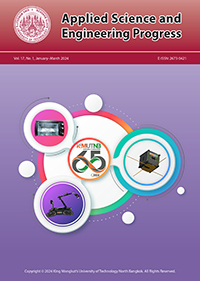Finite Element Investigation of Angle Ring Confinement for Clustered Large-size Stud Shear Connector in Full-Depth Precast Concrete Bridge Deck Panel
Main Article Content
Abstract
Full-Depth Precast Concrete (FDPC) bridge deck panel system, consisting of concrete deck and steel girders, has been used widely for highway and bridge construction due to rapid construction and replacement as well as in terms of economics. This system could integrate with clusters of large size headed-stud shear connectors for more significant connection, although larger composite actions were experienced. Therefore, a new angle steel ring confinement was introduced and tested by push-off samples for the most effective shear transfer. The Finite Element Analysis (FEA) of the push-off model with an in-depth investigation of non-linear concrete properties, boundary parameters, and different geometries of angle ring confinement was developed in this study. The FE models were verified with the push-off test in terms of loads, displacements, and failure stages. Non-linear concrete material models: Concrete Damage (CD) and Drucker Prager (DP) were identified the different abilities either for predicting initial cracks, or determining maximum resistance and critical failure, respectively. The thickness of the angle and the sizes of hook bars were investigated for the most effective aspects of the angle ring confinement. The results showed comparable stiffness and load resistance for various aspects. However, compatible geometries, either 5 mm thick angles with DB12 hook bars or 10 mm angles with DB25 hook bars, were suggested. The final non-linear FEA model was reliable for comparative studies to FDPC push-off with different confinement configurations.
Article Details
References
T. Yamane, M. K. Tadros, S. S. Badie, and M. C. Baishya, “Full-depth precast prestressed concrete bridge deck system,” Prestressed/Precast Concrete Institute (PCI) Journal, vol. 43, no. 3, pp. 50–66, 1998.
The American Association of State Highway and Transportation Officials (AASHTO), AASHTO LRFD Bridge Design Specifications, 6th ed. Washington, DC: AASHTO, 2012.
S. S. Badie, M. K. Tadros, H. K. Kakish, D. L. Splittgerber, and M. C. Baishya, “Large studs for composite action in steel bridge girders,” Journal of Bridge Engineering, vol. 7, no. 3, pp. 195–203, 2002.
S. S. Badie, A. F. M. Girgis, M. K. Tadros, and K. Sriboonma, “Full-scale testing for composite slab/beam systems made with extended stud spacing,” Journal of Bridge Engineering, vol. 16, no. 5, pp. 653–661, 2011.
K. Sriboonma and S. S. Badie, “Practical steel confinements for wildly spaced clustered large stud shear connectors in composite bridge deck panel systems,” in 2010 Structures Congress, pp. 3216–3227, 2010.
K. Sriboonma and S. Pornpeerakeat, “Experimental investigation of steel confinement of clustered large-size stud shear connector in full-depth precast bridge deck panel,” Key Engineering Materials, vol. 856, pp. 99–105, Aug. 2020.
K. Sriboonma, “Fatigue behavior of steel ring confinement for a clustered stud shear connector in full-depth precast concrete bridge deck panel,” Materials Today: Proceedings, vol. 52, pp. 2555– 2561, Jan. 2022.
S. Fang, S. Zhang, Z. Cao, G. Zhao, Z. Fang, Y. Ma, H. Jiang, “Effects of stud aspect ratio and cover thickness on push-out performance of thin full-depth precast UHPC slabs with grouped short studs: Experimental Evaluation and Design Consideration,” Journal of Building Engineering, vol. 67, May 2023, Art. no. 105910.
J. Wang, Q. Xu, Y. Yao, J. Qi, and H. Xiu, “Static behavior of grouped large headed stud- UHPC shear connectors in composite structures,” Composite Structures, vol. 206, pp. 202–214, Dec. 2018.
R. Tawadrous and G. Morcous, “Design of shear pocket connection in full-depth precast concrete deck systems,” Engineering Structure, vol. 179, pp. 367–386, Jan. 2019.
G. Morcous and R. Tawadrous, “Circular shear pocket connection for full-depth precast concrete deck construction,” Journal of Bridge Engineering, vol. 26, no. 5, May 2021, Art. no. 04021019.
M. M. Mia and A. K. Bhowmick, “A finite element based approach for fatigue life prediction of headed shear studs,” Structures, vol. 19, pp. 161–172, Jun. 2019.
J. Qi, J. Wang, M. Li, and L. Chen, “Shear capacity of stud shear connectors with initial damage experiment, FEM model and theoretical formulation,” Steel and Composite Structures, vol. 25, no. 1, pp. 79–92, Sep. 2017.
ABAQUS Analysis User’s Manual, Version 6.13, Dassault Systemes Simulia, Inc., Providence, RI, USA, 2013.
S. Popovics, “A numerical approach to the complete stress strain curve for concrete,” Cement and Concrete Research, vol. 3, no. 5, pp. 583–599, Sep. 1973.
T. H. H. Pian and K. Sumihara, “Rational approach for assumed stress finite elements,” International Journal for Numerical Methods in Engineering, vol. 20, no. 9, pp. 1685–1695, Sep. 1984.


